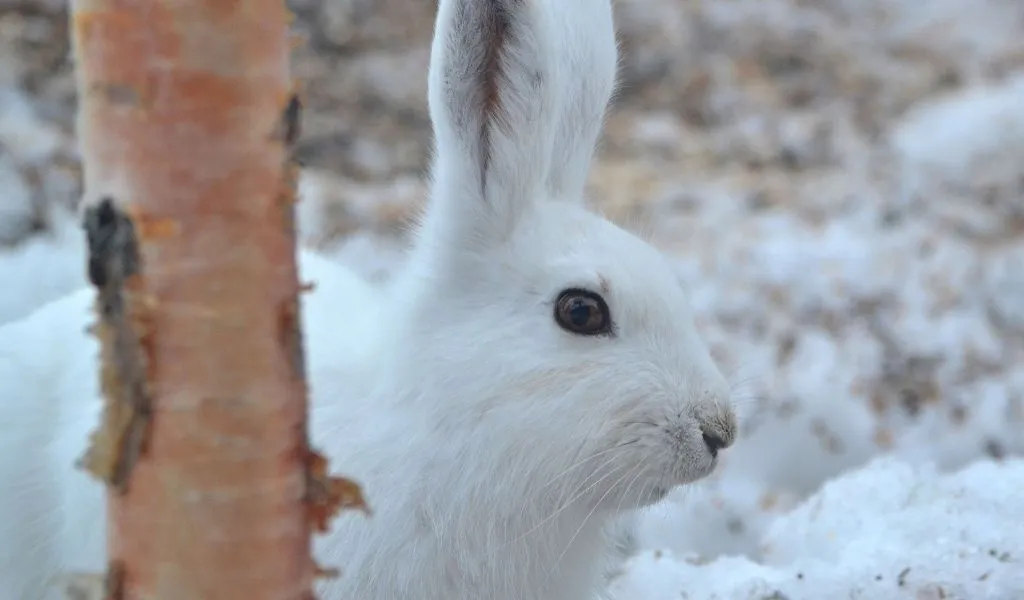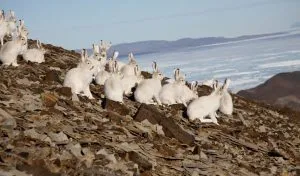A hare more interesting than your average rabbit or bunny, arctic hares are an amazing example of how animals have evolved to live in extremely cold climates where food is often scarce. So what do arctic hares eat in such a cold environment?
Arctic hares are almost entirely herbivorous because they do not eat other animals. Their diet is mostly made up of berries, grasses, and other plants. However, in colder months when berries and grasses are scarce, arctic hares eat woody parts of plants such as birch and willow twigs, roots, bark, moss, and lichen.
Although Arctic hares have not been observed hunting or killing other animals for food, arctic hares sometimes scavenge on animal corpses. Keep reading to find out more about the diet of arctic hares and how they find food even when it is buried under the snow.
Is The Arctic Hare a Herbivore or Carnivore?
Just like regular hares, arctic hares are almost entirely herbivorous1 (source: Pulliainen, E. (1972). Nutrition of the arctic hare (Lepus timidus) in northeastern Lapland. Annales Zoologici Fennici, 9(1), 17–22.), meaning they do not eat other animals.
Arctic hares have not been observed hunting or killing other animals for food. However, sometimes arctic hares might find fish, birds, or mammals that have already died and arctic hares have been seen scavenging on these animal corpses.
Other herbivores including the snowshoe hare are also known to scavenge on meat. Scientists believe the extra nutrients (especially protein) might help these animals survive the winter months when other food sources are scarce2 (source: Peers, M. J, et al. 2018. Scavenging by snowshoe hares (Lepus americanus) in Yukon, Canada. Northwestern Naturalist, Vol 99 Issue 3).
What Does an Arctic Hare Eat?
Arctic hares eat a wide variety of plants. This means they can always find food even in winter when many plants lose their foliage or are buried under the snow. In the warmer months, hares eat berries, grasses, and the leaves and stem of young plants3 (source: Pulliainen, E. (1972). Nutrition of the arctic hare (Lepus timidus) in northeastern Lapland. Annales Zoologici Fennici, 9(1), 17–22.).
In winter, many plants and berries are not available and so arctic hares eat mostly birch and willow twigs, neither of which are very nutritious but are readily available during the colder months. Arctic hares also eat moss and lichen in winter which they dig up from under the snow4 (source: National Geographic).
Arctic hares have also been observed eating animal corpses including fish, birds, and other mammals.
How Do Arctic Hares Hunt?
Arctic hares are not known to hunt or kill other animals for food, but they will eat dead animals if they happen upon them. It is not known whether Arctic hares actively seek out dead animals to eat.
Arctic hares might eat animals that have died of natural causes, that were leftover from other predators, or that were used to bait traps set out by hunters trying to catch larger animals5 (source: Government of Nunavut).
How Do Arctic Hares Forage?
Arctic hares are typically solitary animals but will aggregate in large groups to forage for plants6 (source: Klein, D. R. (1999). Comparative social learning among arctic herbivores: the caribou, muskox and arctic hare. Mammalian social learning: comparative and ecological perspectives, 126-140). They have been observed gathering in groups of up to 300 individuals7 (source: New Hampshire PBS). There are three reasons scientists think arctic hares might prefer to eat together, even though they are mostly solitary animals
1. Avoid predators
By eating in a large group, arctic hares can look out for predators together. Even if only one or two hares spot a predator approaching the group, this is enough to alert the group to the predator’s presence8 (source: Klein, D. R. (1999). Comparative social learning among arctic herbivores: the caribou, muskox and arctic hare. Mammalian social learning: comparative and ecological perspectives, 126-140).
Luckily, due to their long legs, arctic hares are very fast (according to National Geographic, they can reach speeds of up to 40 miles per hour) and by foraging together, most hares in the group will be able to escape the predators.
2. Find a mate
Arctic hares might eat together if it makes it easier to find a mate. By all meeting in one place to forage, arctic hares can take advantage of being together and look for a mate at the same time
3. Good foraging spots are hard to find
In winter there may only be a few places where plants have yet to lose their foliage. Arctic hares might all meet in one place if it is the only place to find food above the snow9 (source: Klein, D. R. (1999). Comparative social learning among arctic herbivores: the caribou, muskox and arctic hare. Mammalian social learning: comparative and ecological perspectives, 126-140).
Related Questions
How Do Arctic Hares Find Food in Winter?
Arctic hares can still find food in winter thanks to their great sense of smell which they use to find moss, lichen, and woody plants, even when they are buried under the snow10 (source: National Geographic). They also have strong claws on their front feet to help them dig beneath even thickly packed snow in order to get to the food below11 (source: The Royal Canadian Geographical Society).
Do Arctic Hares Eat Lemmings?
Arctic hares might eat lemmings if they find a lemming that has already been killed by another predator or that has died of natural causes. However, arctic hares have not been observed hunting or killing other animals for food.
Do Arctic Hares Eat Grass?
Yes, arctic hares do eat grass, especially in the warmer months when it is readily available12 (source: Pulliainen, E. (1972). Nutrition of the arctic hare (Lepus timidus) in northeastern Lapland. Annales Zoologici Fennici, 9(1), 17–22.).
Do Arctic Hares Eat Fish?
Arctic hares might eat fish that have already been killed. Although arctic hares can swim13 (source: Northwest Wildlife Preservation Society), they are not known to hunt or kill fish.
Do Arctic Hares Eat Berries?
Yes, arctic hares eat berries when they are available in the Arctic. Berries contain lots of nutrients that arctic hares need including carbohydrates, fiber, and vitamins.
Do Arctic Hares Eat Arctic Poppies?
Yes, arctic hares do eat arctic poppies and other flowers when they are available. This photo shows an arctic hare eating poppies in Thule, Greenland.
Do Arctic Hares Eat Snow?
Yes, arctic hares do eat snow and ice to keep themselves hydrated as freshwater sources aren’t always available in the Arctic14 (source: Wikipedia).


